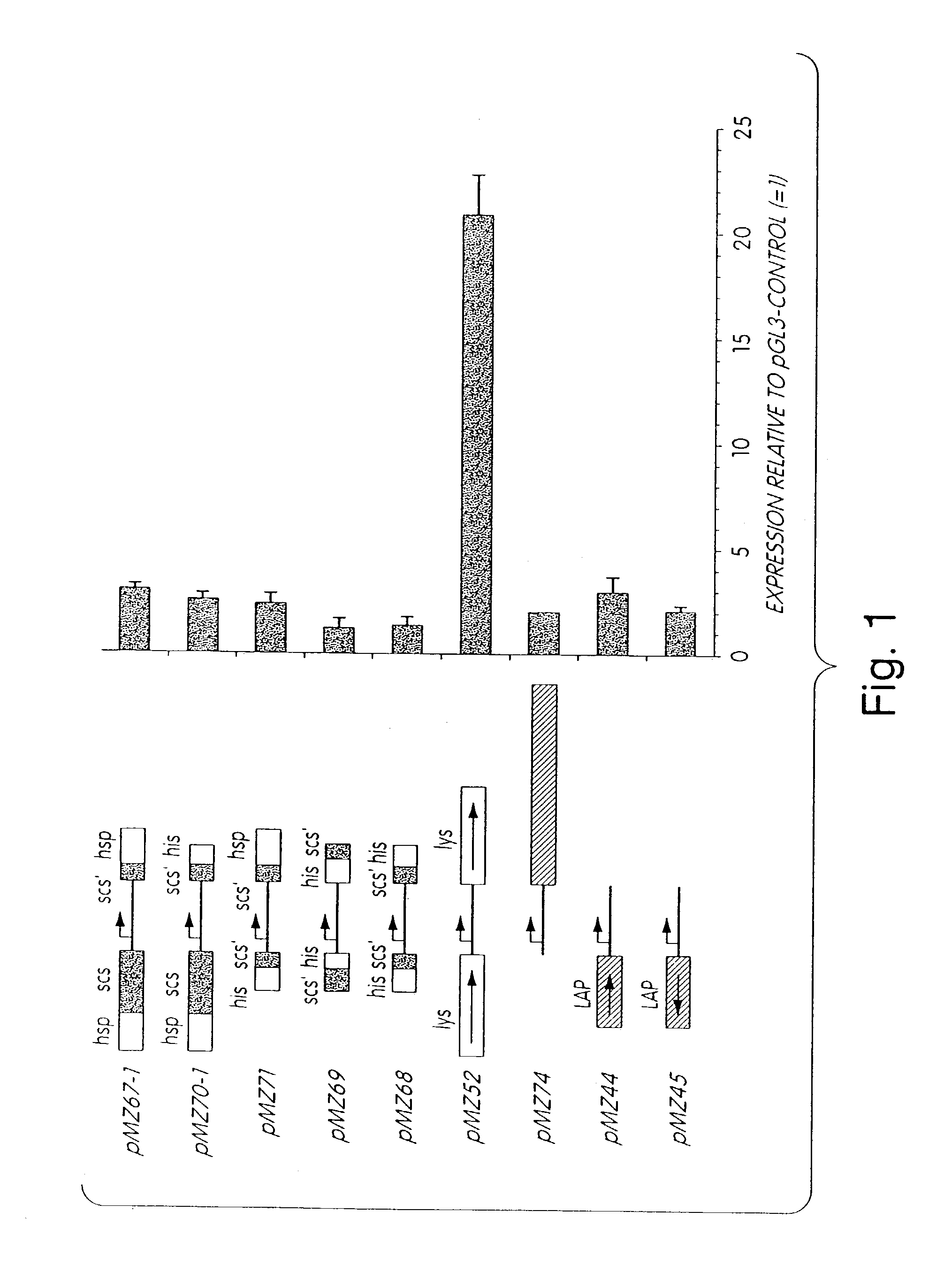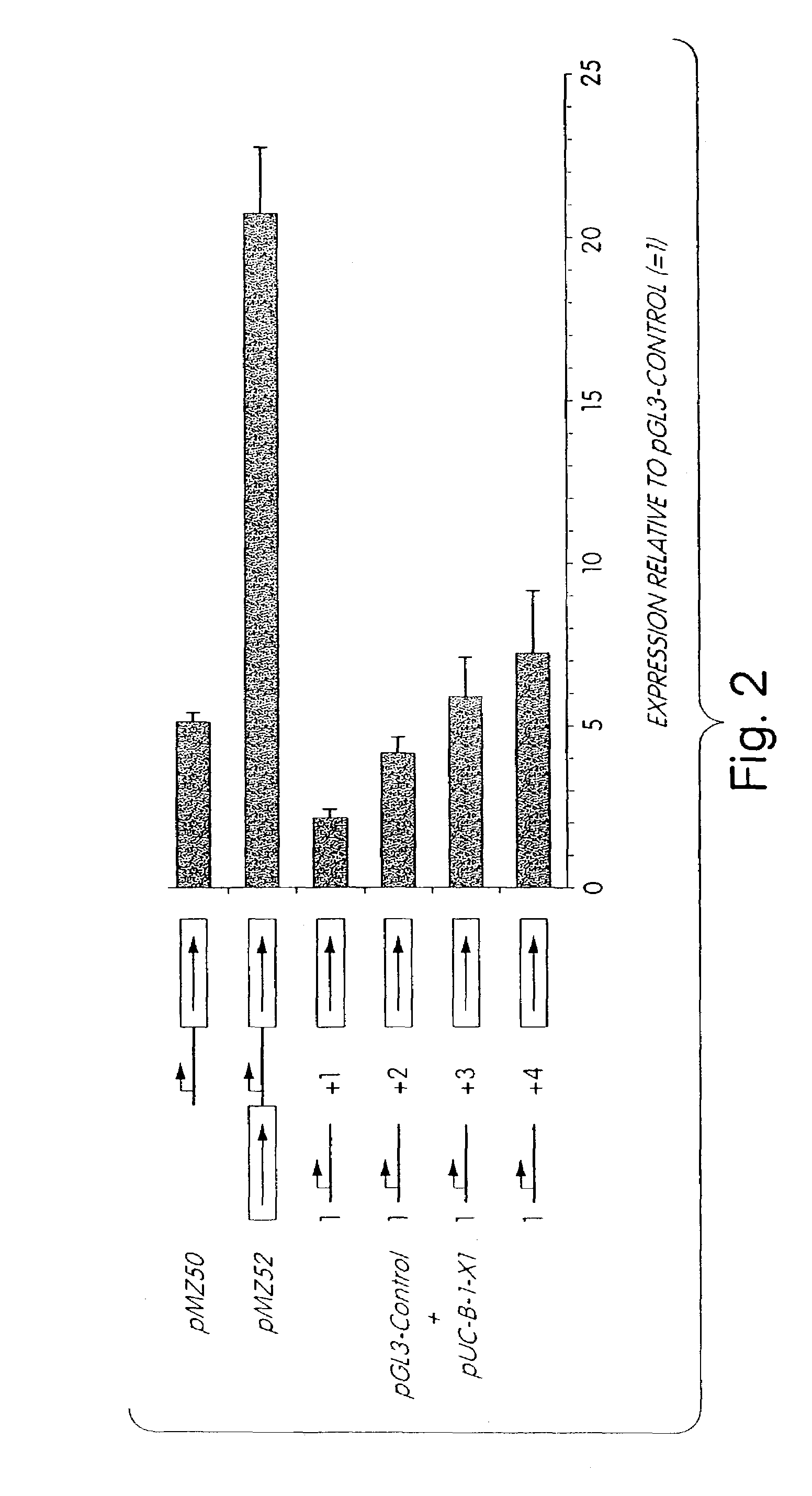Matrix attachment regions and methods for use thereof
- Summary
- Abstract
- Description
- Claims
- Application Information
AI Technical Summary
Benefits of technology
Problems solved by technology
Method used
Image
Examples
example 1
General Materials and Methods
[0084]Plasmid construction. The luciferase expression vectors used to test the chromatin elements are all based on pGL3-Control (Promega). This plasmid contains an SV40 promoter in front of a modified firefly luciferase cDNA, followed by the SV40 late poly(A) signal and the SV40 enhancer. The Drosophila melanogaster elements come from the p7, p83 and p 1314 plasmids (Poljak et al., 1994). The 1.8 kb SalI scs (special chromatin structure) BE fragment comes from p83, as well as the 960 bp BamHI-XhoI heat shock 87A locus SAR (hsp SAR). The 500 bp BamHI scs' BE fragment is derived from p7, whereas the 657 bp EcoRI-HinfI histone SAR (his SAR) comes from p1314.
[0085]Combinations of these elements were first cloned into the BamHI SalI sites of pGL3-Control. The scs' BE and hsp SAR were cloned as BamHI-EcoRI and EcoRI-SalI fragments respectively, giving pMZ61. Similarly, the BamHI-EcoRI scs' BE fragment and EcoRI-SalI his SAR fragment were inserted to give pMZ62...
example 2
Chromatin Elements and Stable Transgene Expression in CHO Cells
[0092]The use of structural chromatin components to overcome silencing of stably integrated genes by the surrounding chromosomal environment will prove particularly useful in biotechnology. Unfortunately, fully characterized chromatin elements in higher eukaryotes are rare. Moreover, most of these have not been tested with a heterologous promoter in heterologous cells. Elements which counteract the effect of neighboring chromatin structure on stable transgene expression are expected to raise the average transgene expression in pools of stable clones, where the effects of different integration sites and the number of active copies become averaged.
[0093]Single chromatin elements or combinations of chromatin elements were cloned on either, or both sides, of the luciferase expression unit of pGL3-Control as depicted in FIG. 1. Various combinations of Drosophila melanogaster SAR and BE elements were tested flanking the report...
example 3
Co-transfection of the MAR Improves Stable Transgene Expression
[0095]An alternative strategy to cloning the MAR element into the reporter expression vector is that of co-transfecting a MAR element-containing plasmid with the transgene expression vector. The observation that transfection with multiple plasmids appears to result in co-integration of multiple plasmid copies at the same chromosomal site (Wurm et al., 1992) suggests that the MAR element does not need to be physically linked with the transgene expression cassette at the time of transfection. However, the organization of the various integrated plasmids, and how these may recombine to generate the integrated DNA, is not known. A significant increase in stable transgene expression level is observed when MAR elements flank both sides of the reporter gene expression cassette, suggesting that a precise order of the genetic elements is required. While MAR orientation does not affect stable expression, a particular arrangement wi...
PUM
| Property | Measurement | Unit |
|---|---|---|
| Molar density | aaaaa | aaaaa |
| Concentration | aaaaa | aaaaa |
| Efficiency | aaaaa | aaaaa |
Abstract
Description
Claims
Application Information
 Login to View More
Login to View More - R&D
- Intellectual Property
- Life Sciences
- Materials
- Tech Scout
- Unparalleled Data Quality
- Higher Quality Content
- 60% Fewer Hallucinations
Browse by: Latest US Patents, China's latest patents, Technical Efficacy Thesaurus, Application Domain, Technology Topic, Popular Technical Reports.
© 2025 PatSnap. All rights reserved.Legal|Privacy policy|Modern Slavery Act Transparency Statement|Sitemap|About US| Contact US: help@patsnap.com



